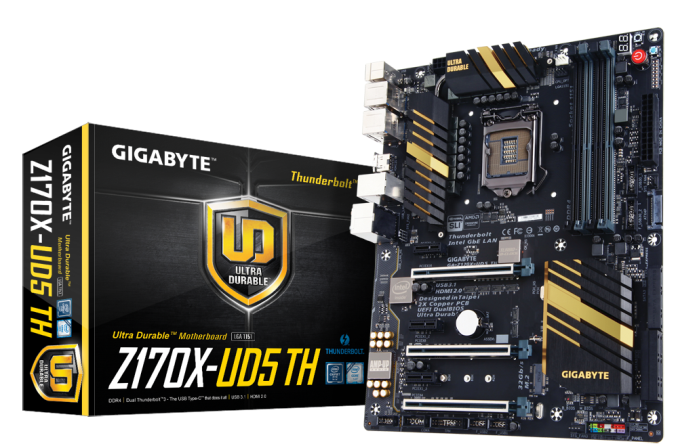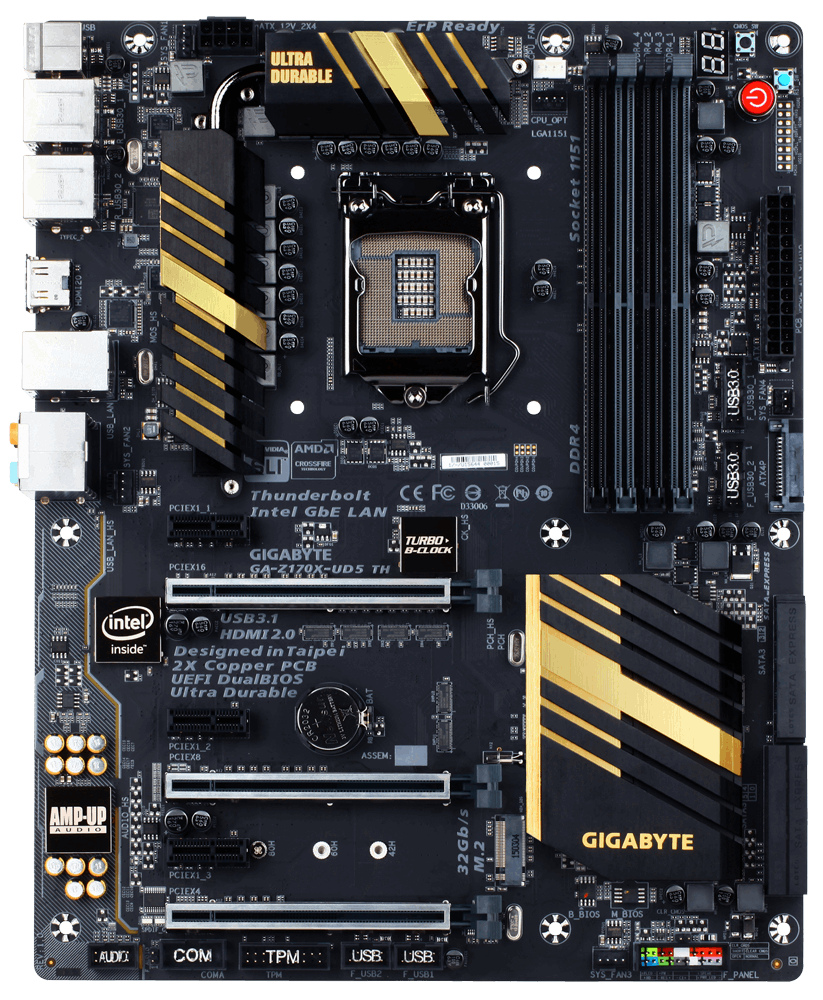The GIGABYTE Z170X-UD5 TH Motherboard Review: An Entry to Thunderbolt 3
by Ian Cutress on February 19, 2016 9:00 AM EST- Posted in
- Motherboards
- Gigabyte
- Thunderbolt
- Skylake
- Z170
- Thunderbolt 3
The Thunderbolt 3 Bandwagon
One of the main reasons why some users buy certain motherboards is due to a specific feature. If you need to use a specific feature that only some models have, it guts out 98% of potential candidates at the first step. Typically most users will separate by compatibility and price first if they don’t need a certain specific feature, but it means that when we look for Thunderbolt 3 enabled motherboards, the Z170X-UD5 TH comes in at one of the cheapest models available and only $6 more than the non-Thunderbolt 3 variant.
As can be the issue with early adoption though is the lack of devices currently using the standard. We saw similar issue with the previous two generations of Thunderbolt, especially when it came to Windows compatibility (most devices ended up focused on Apple), or things like SATA Express that never took off. Perhaps SATAe is an odd-ball standard anyway, but it still stands to reason that TB3 devices are thin on the ground. Standard expectations will put it on the next generation MacBook Pro and Mac Pro devices, as well a display or two, but we are going to have to wait for other storage/hub options to come through. There’s also the issue of cabling – TB3 requires an active cable to reach 40 Gbps, whereas a cheaper passive cable will only be rated for 20 Gbps. Nonetheless, it comes back to that $6 difference; if you can use the ports for USB 3.1 in the meantime, then it can make it an easy decision to spend the extra for the price of a large double-shot coffee.
Moving away from the Thunderbolt 3 aspect and we have GIGABYTE’s main stream Ultra Durable brand motherboard sitting between the UD3 and UD7. This means it gets the UD black/gold branding, some upgraded power delivery, GIGABYTE’s new PCIe protection guard scheme to avoid slots being ripped out by large cards and storage options in M.2. The UD5 TH is also one of the few motherboards that will support HDMI 2.0 (HDCP 2.2), in this case using a LSPcon, when the integrated graphics are in play. It seems a little odd to be upgrading the integrated graphics options with a motherboard aimed at discrete GPU users, however GIGABYTE clearly sees a benefit here when non-GPU PCIe devices are in use instead.
There’s also some upgraded Realtek ALC1150 audio using PCB separation, filter caps and EMI shielding, with RGB LEDs underneath the motherboard on the digital side for users that want to pimp their rig. There’s another interesting choice in using an EMI shield for the Intel I219-V network controller, as this tends to make little difference in performance. There’s also the three SATA Express ports, but the only thing that can use them that is for sale is a USB 3.1 front panel bay which of course, sells separately.
In the performance metrics, the Z170X-UD5 TH does use MultiCore Turbo, but only on certain benchmarks – we saw video encoding and 7-Zip encoding were MCT enabled, but WinRAR encoding and ray tracing were not. This gave the performance a mid-range outing between those that do enable MCT and those that do not. For the system benchmarks, idle power and POST time were the best we’ve seen so far on Skylake, but load-to-idle delta and DPC Latency were nothing to write home about. GIGABYTE also implements their classic mode BIOS only here, avoiding the HD mode altogether, but the software package is easier to use and update than previous generations.
For users interested in water cooling, it is worth noting that EKWB has a CPU plus power delivery water block available for the Z170X-UD5 TH using G1/4 fittings at €118. For some of the markets that GIGABYTE aims for, having tie-ins with extra hardware manufacturers can be a good thing, especially for users wanting to expand designs beyond a simple cooler and memory.
There are a few oddities, such as HDMI 2.0 on a GPU focused motherboard, having three SATAe ports but no SATAe drives in the market, and having the M.2 slot muxed with the final PCIe slot rather than having them separate as is possible with the Z170 chipset. The first two of those most users will ignore anyway, but there is certainly an element of design here that warrants the price point. The GIGABYTE Z170X-UD5 TH is a good motherboard by most metrics. I have since handed it off to Ganesh to update one of his NAS/Thunderbolt testing systems, as it was one I had that would fit the bill. The board is one of the most appealing to those wanting to invest in Thunderbolt 3, as and when devices enter the market - especially if it is still only $6 more than the non-TH version, and that will most likely be the biggest draw.












29 Comments
View All Comments
Folterknecht - Friday, February 19, 2016 - link
With a DPC Latency of ~250 I 've my doubts.alamilla - Friday, February 19, 2016 - link
To clarify, I was referring to round trip audio latency.Thunderbolt can achieve 2-3 ms of latency (without the heavy CPU penalty when compared to USB) which is essential in recording environments where several plug ins may be being used on a DAW channel strip whilst tracking.
Universal Audio, Apogee and Pro Tools have used it on their audio interfaces for years but unfortunately only support OS X.
With TB3 now more readily available there may be more widespread adoption as thus far only MOTU (and to a degree Focusrite) have provided support for Windows.
dtgoodwin - Friday, February 19, 2016 - link
If Intel wants TB3 to be successful, they need to include it for no extra cost above the AR controller.extide - Monday, February 22, 2016 - link
Huh, not sure I understand. You buy the AR controller you get TB3, maybe you meant they should include it directly in the chipset?dreamcat4 - Friday, February 19, 2016 - link
Hi there,It is also at least worth mentioning that there are certain other Gigabyte boards which also have the thunderbolt capability. It is formally advertised on their Z170X Gaming 7, and Gaming G1. Which are the premium / more expensive ones.
However I also heard from another Gigabyte owner that with a newest BETA bios, he got his G170X Gaming 5 to also register / recognize TB3 support. It had been switched on too around that same time as the other ones. Just not advertised by Gigabyte and/or certified by Intel.
I mention it because many people already buy the Gaming 5 for other reasons. Indeed its very popular out of all Gigabyte's entire Z170 range. So for those guys who already have something else... might as well upgrade your BIOS and give it a try.
You also need to download the TB3 Driver Utility from Gigabyte's support website. Its the same version for all of these Gigabyte boards. Can get it from the UD5-TH's support page / tab.
Note: TB3 doesn't work on Gaming 3 (or lower), as I have checked myself. It is likely missing such optional TCON / PHY and different PCI-e lanes wiring / layout. So with those ones the Alpine Ridge chip can only provide USB 3.1.
klagermkii - Friday, February 19, 2016 - link
One of the only reasons I would get Thunderbolt 3 on a desktop is as a cheap-ish way to get 10Gbps networking between two devices. Could you do a test on TB3 networking to see if it's any good and the kind of performance one gets from SMB3 on it?I_Know_God - Thursday, February 25, 2016 - link
I know its not as sexy, but you can use SMB multi-channel to get pretty good results without the cost. I plugged two NIC's into my NAS and two into my desktop and got 180MB/s transfer speed to and from.Cost is about as much as an extra network card and cable someplace.
torchedguitar - Friday, February 19, 2016 - link
Can anyone confirm that this board's HDMI 2.0 port handles the full 18 Gbps speed? A lot of things that claim "HDMI 2.0" can support the features, but run at the lower 10.2 Gbps speed of HDMI 1.4b. An easy way to test this is to connect it to a 4K TV, run full 3840x2160 at 60 Hz, and verify there is no chroma subsampling (i.e. you want 4:4:4, not 4:2:0). A way to check for chroma subsampling if the driver doesn't make it obvious (Intel's software is weak there) is to make an image with purely-blue text in a small font on a purely-red background: it will look as expected with RGB or YUV4:4:4, but will be totally unreadable with YUV4:2:0.KimGitz - Saturday, February 20, 2016 - link
Yes it offers 18Gb/s of bandwidth. It also supports native cinematic 21:9 ratio.GoMoeJoe - Friday, February 19, 2016 - link
Any Z170 based mobo what still uses a shared M.2 is unacceptable.Especially the way these clowns did it on this product ...